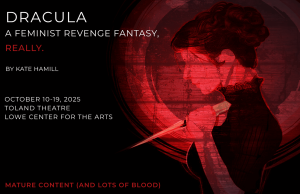Math predicts no chance of human survival in zombie, vampire attacks
November 6, 2014
On Thursday, Oct. 30, UW-L mathematics professors Robert Allen and James Pierce gave a humorous, festive Halloween presentation in Cowley Hall about what would happen to the rest of the population if mythical creatures bit one individual in the population, and then another and another, until all that remained were vampires and zombies.
Allen and Pierce started off by giving some background.
Zombies, in West African cultures, had no will of their own, and they acted as slaves to a bokor, or sorcerer. In these cultures, the sorcerer could revive a dead person. In South African cultures, a child could turn a dead person into a zombie by killing and possessing the body. These zombies were then used as slaves to the person that created it. In popular culture, on the other hand, zombies are undead beings that thirst for human flesh and are usually created from some virus, which is accidentally released into the population.
The first appearance of the word vampire was “upir” in 1047 in reference to a Russian prince. In 1710, vampire hysteria swept through East Prussia.
Pierce noted, “There is much scientific evidence to prove that vampires are indeed real things.”
One of the examples of evidence presented by Pierce that suggests vampires are real is porphyria, which is a group of diseases that lead to deposition of toxins in the skin. The sufferers of this disease express sensitivity to light, intolerance to garlic, and erosion of the lips and gums. Another piece of evidence that suggests vampires are real is mycobacterium and tuberculosis. The victims appear very pale, often avoid sunlight and spit up blood. The last piece of evidence he presented was a disease called catalepsy, which causes the slowing of the heartbeat and breathing which makes a person appear dead.
Allen and Pierce used different mathematical models to simulate what would happen in these situations. Allen explained the Basic Model, in which it would be assumed that when a human is bitten or scratched by a zombie, the human is instantly turned into a zombie. In this case, if there were 500 humans and 50 zombies entered the population, math shows that all of the humans would die out quickly, and the zombies would prevail.
Allen also used this same model to predict what would happen to the population if there were still 500 humans but only one zombie in the population. In this case, the results would be the same: zombies would eventually prevail and outlive all of the humans, however, it would take a longer amount of time.
Although most of the mathematical models they presented suggested that all humans would die if one of these creatures entered the population, they made the point that humans and vampires and/or zombies can coexist with each other, and over time, the population would be expected to level off.
They also made the point that no matter what a student’s major is, be it biology, marketing, sociology, psychology or English, math can help them explore their field in different ways.





